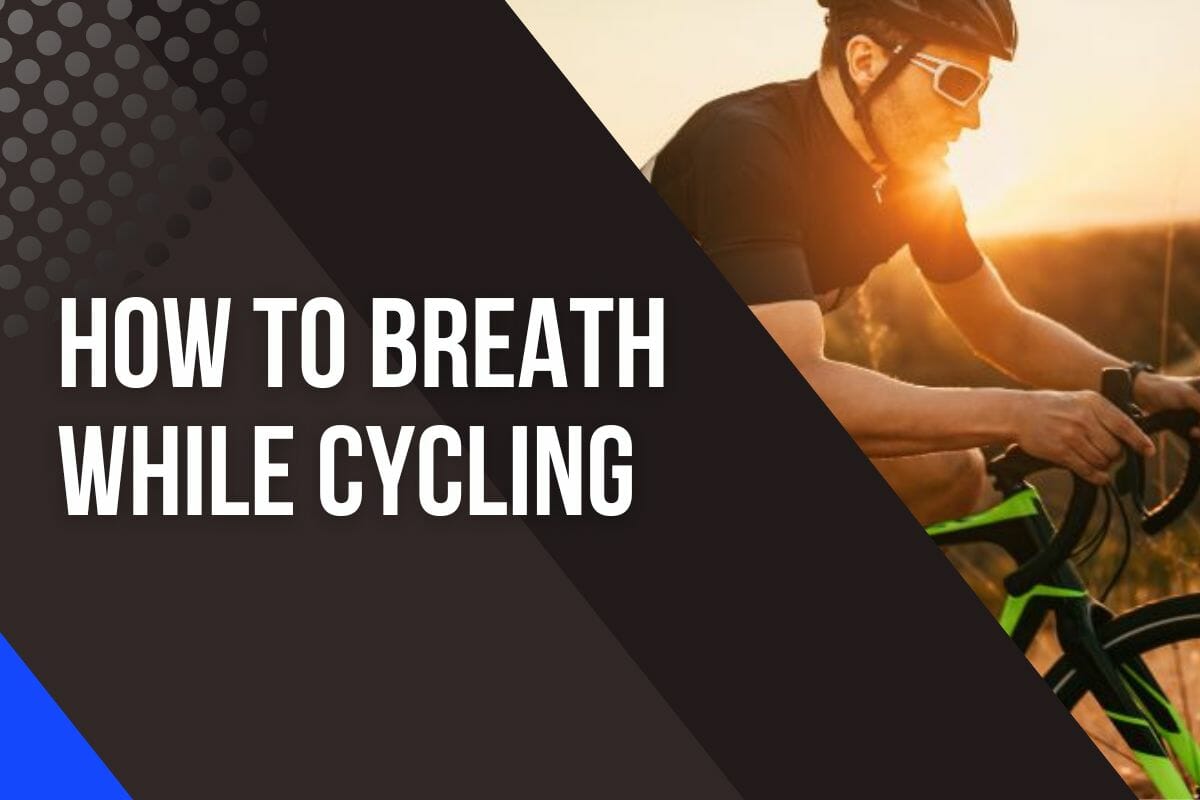How To Breathe While Cycling

Are you struggling with your breathing while cycling?
If so, then you need to learn how to breathe properly.
Just like any other physical activity, proper breathing techniques can help enhance your performance and reduce fatigue on the bike.
In this article, we’ll explore the facts about your lungs and why it is important to breathe properly while cycling.
We’ll also discuss three breathing methods that can be used for cycling as well as tips for training respiratory muscles, mental focus, and overcoming pre-race nerves.
So, let’s get started by learning more about how to breathe while cycling!
Facts About Your Lungs
Your lungs are an amazing organ, essential for your body to take in oxygen and expel carbon dioxide.
The capacity of an adult’s lung is approximately 6 liters, but this varies from person to person depending on height, weight, age, and gender. (1)
Taller people have larger lungs than smaller people, and men tend to have greater lung capacity than women.
However, there is some bad news when it comes to your lungs: you can’t make them bigger, no matter how hard you train.

Moreover, age plays a factor in determining lung capacity; as we get older, our lung capacity tends to decrease significantly.
Studies show that a cyclist in his or her 80s has a lung capacity of only around half of one who is in his or her twenties.
Even so, regardless of age or any other external factors, most of us don’t use our full lung capacity even when exercising.
We often don’t know how much strength our lungs really carry within them!
The Importance Of Breathing Techniques
When it comes to breathing, most of us go about our daily lives without putting much conscious effort into it.
We simply breathe unconsciously, allowing our bodies to take care of the process without having to be cognizant of it.
This passive form of breathing is effective when we’re going through the motions and not overly exerting ourselves, such as during routine tasks like walking or jogging.
However, this is not always the best approach when we are performing more strenuous activities, particularly something like cycling.
It’s important to be mindful of how you breathe when engaging in rigorous physical activity.
Diaphragmatic breathing (also known as belly breathing) can help you get more oxygen into your body and will help you make better use of your energy reserves while enhancing your endurance.
Practice Diaphragmatic Breathing
The diaphragmatic or belly breathing technique is the ultimate weapon in breathing efficiency.
It requires your body to use its respiratory muscles to draw air deep down into your abdomen, rather than just shallowly in and out through your chest.
The modern lifestyle which forces people to sit for too long can weaken your diaphragm and make you do shallow chest breathing.
Practicing belly breathing will strengthen your diaphragm muscle. The practice focuses on using abdominal pressure to fill the lungs and expel as much air as possible.
Belly breathing has numerous benefits beyond simply improving oxygen intake during physical activity.
It can help relieve stress and anxiety by slowing down the heart rate and calming our nervous system.
This involves focusing on consciously expanding your abdomen as you inhale and contracting it as you exhale.
1. Three Seconds In, Three Seconds Out
The “three-in, three-out” breathing technique is one of the best ways to ensure you’re taking in enough oxygen during rides.
First, you should practice this basic exercise off the bike to get the feel.
This method requires that you inhale for three seconds, then exhale for three seconds – repeat.
Do 10 repetitions for 1 minute to get noticeable benefits. You may not be able to do it on your first try but with regular practice, it’s easy to get there.

Make sure to lay your hands on your sternum (top of your abdomen) to feel your stomach as you inhale and exhale.
This helps to regulate your breathing rate so that it remains consistent throughout your ride.
It took me some time to get used to the rhythm at first, but eventually, I was able to master the technique.
2. Count The Pedal Stroke And Breath Accordingly
Breathing on a bike can become very challenging when faced with long climbs or fast technical downhills.
It’s common for cyclists to find themselves feeling short of breath or even dizzy at times due to the extra effort required.
Luckily, there is a way to better control your breathing on these occasions: pedal stroke breath counting.

Pedal stroke breath counting consists of breathing in rhythm with each pedal stroke.
This technique can help bring the focus back to the action of breathing and letting in more air, while at the same time helping regulate consistencies over extended periods.
- The best place to start practicing this is either on a home trainer or on a familiar flat course, where the goal should be to settle into a cadence of 90-95 rpm in moderate gear.
- From here, inhale for 3 down-strokes followed by exhaling for 6 down-strokes, forcing out the air audibly as they do so.
- Adjust the number of pedal strokes according to the terrain and your lung capacity. Always assign more strokes when exhaling.
It may take some time to perfect this counting technique but it will pay off when you find yourself easily able to cycle longer distances without feeling winded!
3. Practice The Altitude Breathing Technique
Altitude breathing can be an effective way of training simulation for those preparing for events that take place in higher altitudes. (2)
- This exercise involves walking at a normal pace and then taking 10 steps while exhaling, holding your breath, and avoiding any inhalation.
- After the 10 steps are completed, you should take 2-3 steps of normal breaths.
- Exhale, hold your breath and take 15 steps. Once you reach the end, repeat and add five more. Keep up this pattern until you reach 50 steps.
This simulates an altitude of 2,000 meters and is designed to strengthen your body’s respiratory system.
Over time, this exercise can help athletes become more accustomed to increased oxygen intake and various levels of physical stress.
If you’re cycling in mountainous terrain, your body will need to adjust to the change in altitude.
This means that there may be less oxygen available for respiration, and it’s important to understand how this affects your breathing while cycling.
At higher altitudes, the air pressure is lower – which means the amount of oxygen per breath decreases as well.
Your lungs must work harder and faster to get enough oxygen into your bloodstream each time you inhale.
This can lead to shortness of breath or even a feeling of being winded after exerting yourself at high altitudes.
Body Position On The Bike Affects Your Breathing
One of the most important elements to consider when creating a comfortable and effective cycling position is your diaphragm.
If you are hunched over the handlebars, your diaphragm may not have enough space to move freely and this will limit your oxygen intake.
It is important to find a balance between being aerodynamic and making sure your body has enough room to breathe properly.

For time trial cyclists, experimenting with different positions on the bike can help you work out which one best suits your needs before tackling a challenging course.
For sportive riders it’s easier to maintain a good riding position as they usually adopt an upright posture on the bike, freeing up space for the diaphragm.
However, this doesn’t mean that cyclists shouldn’t take regular breaks from their rides or adjust their bike specifications to achieve maximum comfort and performance.
Paying attention to how comfortable you feel when cycling can significantly improve the quality of your ride and provide you with the opportunity for successful long-term training sessions.
Why It Is Crucial To Breathe Properly While Cycling
As a cyclist, it’s incredibly important to ensure that you are breathing deeply and rhythmically so that you can take full advantage of the oxygen-filled air and deliver the necessary oxygen to your muscle tissue.
When you cycle, you are constantly inhaling more oxygen to supplement energy expenditure and exhale carbon dioxide as waste gas.
Chest breathers will tire more quickly because their lungs don’t have the capacity to inhale enough oxygen or exhale enough carbon dioxide compared to those who practice belly breathing or diaphragmatic breathing technique.
Not only does proper breathing improve endurance while cycling, but it also helps deliver more oxygen to our brain which can help improve concentration and performance with every kilometer we pedal away.

Additionally, good respiratory control helps maintain the acid/base balance in the body by increasing the flow of oxygen and decreasing carbon dioxide.
Carbon dioxide increases acidity levels in our bodies, which peaks during physical workouts such as cycling.
Proper breathing ensures that this build-up of acidity is offset and we can avoid unnecessary fatigue on long rides.
Breathing And Mental Focus
To ensure that your mind remains engaged when you’re cycling, take a few moments before setting off to prepare mentally.
As a cyclist, I have found that having good mental focus is essential for getting the most out of my rides.
One way I like to keep my mind focused on the task at hand is by engaging in conscious breathing techniques.
This means taking slow, deep breaths throughout my ride and focusing on taking regular breaths at least 10 times per minute.
Doing this helps me regulate my heart rate and allows me to stay in control while cycling.
Types Of Focus
When it comes to cycling, there are different types of focus that can help improve performance.
My favorite type of focus is what I call “associative” focus. This is where I pay attention to the task at hand and stay in the moment while cycling.
For example, this might include focusing on my cadence, my route, or hitting a power target.
Narrow focus is the process of keeping one’s attention on one task or concept.
It’s a very valuable skill to have in cycling since it can allow you to really hone in on specific details that can help improve your performance.

For example, when riding up an incline or sprinting for the finish line, being able to fixate on certain objectives such as maintaining a certain cadence or choosing an ideal racing line can be invaluable.
Narrow focus can also help cyclists perfect their pedaling form so that they may achieve optimal results and optimum output.
Broad focus is just the opposite and involves looking beyond the immediate task at hand (such as a single hill climb) and instead looking at the bigger picture.
This includes considering your goals for the ride as a whole, assessing what techniques will best get you there, and thinking about how your performance affects that end goal.
External focus requires paying attention to elements outside of yourself such as other riders, their technique, and any changes in road conditions that might affect your ride.
Meanwhile, internal focus is when you pay attention to physical sensations within yourself such as breathing rate or muscle fatigue.
Mastering these different types of focuses is key if cyclists want to maximize their potential on the bike.
Being able to switch between these types of focus helps me stay focused on the ride and allows me to get the most out of it.
Training Focus With Breathing
Mastering breath control is an essential skill for any athlete, but it’s especially important for athletes who are trying to maximize their focus.
When it comes to training focus on breathing techniques, the sweet spot training is particularly beneficial.
Engaging in a circular breathing pattern provides an element of mindfulness, allowing you to stay in the moment and make a concerted effort to stay focused throughout the entire interval.
This can be difficult during longer intervals, but focusing on the breath can help guide these efforts and keep your power at consistent levels throughout.

In addition to sweet spot efforts, associative focus with circumferential breathing techniques can also provide you with the ability to stay sharp and attentive throughout your workout.
Being aware of your breath while exercising allows you to maintain complete awareness and allows you to identify signs of fatigue before they become detrimental to your performance.
With practice and patience, you will be able to hone your focus through mindful movements that hinge on deep breaths and visual cues that remind you of what matters most: powering through without getting fatigued too quickly or having bad posture.
Anxiety And Pre-Race Nerves
I’m never a fan of pre-race nerves, and as an experienced cyclist, I know that they can be detrimental to my performance.
This can be overwhelming, leading to stress, fear, and doubt.
But with the right techniques, you can learn how to cope with these feelings so that they don’t interfere with your performance.
I’ve found breathing exercises to be the most effective way to dial down the pre-race jitters.
As always, my go-to is belly breathing – which involves taking slow, deep breaths through your nose while paying close attention to how your body moves with each pedal stroke.

This technique engages primary respiratory muscles and stimulates the vagus nerve, reducing symptoms of anxiety and nervousness.
Use breathing cadences and breath efficiency to control sympathetic arousal levels.
This does not mean that you should completely avoid being sympathetically active prior to the event, as excitement and sharpness can also serve as beneficial motivators.
Rather, you should work towards finding the ideal spot between calmness and tension which will keep you feeling positive before the gun sounds.
These positive breathing techniques have helped me stay focused and present throughout races without succumbing to pre-race nerves or anxiety.
You can use this technique during your warm-up or on the start line to alter your level of sympathetic activation but it can also be called upon throughout a hard effort when energy levels begin to drop off in order to retain focus and intensity.
With some practice, anxiety does not need to stand in an athlete’s way of achieving success.
Examples of Breathing Properly
One of the best ways to learn how to breathe properly while cycling is to observe great examples.
I’ve found a few of these that have been particularly helpful in improving my own technique.
The first example is infants; they instinctively use their diaphragm to breathe deeply and fully, engaging the primary respiratory muscles and stimulating the vagus nerve.
Watching them has been an invaluable lesson on how to breathe efficiently and reduce pre-race jitters.
Another example is professional cyclists. Watching them on TV, I noticed that they were correctly using this breathing technique.
This gave me an idea of what it looks like when someone is breathing correctly while cycling.
Sneaky Culprits That Prevent You From Having Proper Breathing While Cycling
You need oxygen to keep your muscles working and your energy levels up.
Unfortunately, there are a few things that can prevent proper breathing while cycling.
One of these things is the position of your body on the bike.
If you have a more aggressive stance with your hips closed off, it will make it harder for you to take deep breaths.
This limits the amount of oxygen getting to the muscles, resulting in lower power output and fatigue faster.

Another thing that can prevent proper breathing is shallow or fast breathing rates.
This type of breathing reduces oxygen intake and prevents full engagement of your diaphragm and other respiratory muscles which are necessary for a proper breathing technique.
Finally, improper bike fit can also lead to inefficient breathing while cycling.
If your saddle is too low or too far back, then this will cause you to hunch over and restrict your ability to breathe deeply and fully.
By being conscious of these factors, I have been able to improve my performance by focusing on engaging my abdominal muscles when I’m riding, reducing shallow breath rates, and adjusting my position on the bike as needed for maximum comfort and efficiency.
My Verdict
Learning how to breathe properly using the diaphragm while cycling is an important part of enjoying and performing at your best on the bike.
With a few adjustments to your position on the bike and some practice with breathing exercises, you can improve your riding performance as well as reduce pre-race nerves.
Respiratory muscle training should be done regularly so that over time, it becomes second nature when you’re out riding. That way, you don’t need to think about it – just focus on getting the most from every ride.





